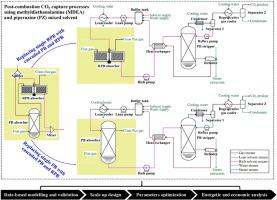通过级联固定和旋转填料床强化哌嗪活化甲基二乙醇胺溶液的工厂规模燃烧后二氧化碳捕集
IF 10
1区 环境科学与生态学
Q1 ENGINEERING, ENVIRONMENTAL
引用次数: 0
摘要
溶剂型填料床燃烧后碳捕集技术(PCC)在商业化过程中存在能耗高、占地面积大的问题。利用旋转填料床(RPBs)强大的分离效率、紧凑的设计和广泛的溶剂适应性,用RPBs取代PBs并将其与节能溶剂集成是实现PCC完全商业化的潜在解决方案。尽管如此,与rpb相关的规模限制和经济不确定性仍然是阻碍其大规模实施的主要挑战。串联/并行使用rpb或与PBs一起使用rpb有望在节省空间和降低成本之间取得平衡,但这种权衡优势尚未被量化。因此,本研究为工业规模甲基二乙醇胺+哌嗪(MDEA+PZ)水溶液中PB和RPB级联组合的PCC提供了详细的能量和经济分析。基于速率的PB和RPB模型首先在Aspen Plus®中开发和验证,其中RPB中高重力特征所需的新相关性被写入Visual Fortran子例程并链接到Aspen Plus®。然后在Aspen Plus®中提出并实施了三种不同的吸收配置(单PB、单RPB或两者的级联),用于PCC工艺,实际规模应用的目标是10,000 m3/h的烟气。结果表明,在0.1 ~ 0.5美元/千瓦时的电价范围内,采用PB和RPB级联组合代替单一RPB,可将总比捕集能从5.19 GJ/tCO2降低到4.30 GJ/tCO2,节约捕集成本达44.58%。本文章由计算机程序翻译,如有差异,请以英文原文为准。


Intensified plant-scale post-combustion CO2 capture based on piperazine-activated methyldiethanolamine solution via cascaded stationary and rotating packed beds
Solvent-based post-combustion carbon capture (PCC) with packed beds (PBs) suffers from high energy consumption and large space occupation in the commercialization process. Benefiting from the strong separation efficiency, compact design and wide solvent adaptability of rotating packed beds (RPBs), replacing PBs with RPBs and integrating them with energy-saving solvents is a potential solution to enable complete commercialization of PCC. Nonetheless, the size constraints and economic uncertainties associated with RPBs remain key challenges hindering their large-scale implementation. Using RPBs in series/parallel or with PBs promises a balance between space savings and cost reduction, but this trade-off advantage has not yet been quantified. Therefore, this work provides a detailed energetic and economic analysis of a cascade combination of PB and RPB for industrial-scale PCC using methyldiethanolamine + piperazine (MDEA + PZ) aqueous solution. Rate-based models for PB and RPB were first developed and validated in Aspen Plus®, where the new correlations required for high gravity characteristics in RPB were written into Visual Fortran sub-routines and linked to Aspen Plus®. Three different absorption configurations (single PB, single RPB, or cascade of the two) were then proposed and implemented in Aspen Plus® for the PCC process with a practical-scale application targeting 10000 m3/h flue gas. The results show that using a cascade combination of PB and RPB to replace a single RPB can reduce the total specific capture energy from 5.19 GJ/tCO2 to 4.30 GJ/tCO2, and save up to 44.58 % of the capture cost over an electricity price range of $0.1–0.5/kWh.
求助全文
通过发布文献求助,成功后即可免费获取论文全文。
去求助
来源期刊

Journal of Cleaner Production
环境科学-工程:环境
CiteScore
20.40
自引率
9.00%
发文量
4720
审稿时长
111 days
期刊介绍:
The Journal of Cleaner Production is an international, transdisciplinary journal that addresses and discusses theoretical and practical Cleaner Production, Environmental, and Sustainability issues. It aims to help societies become more sustainable by focusing on the concept of 'Cleaner Production', which aims at preventing waste production and increasing efficiencies in energy, water, resources, and human capital use. The journal serves as a platform for corporations, governments, education institutions, regions, and societies to engage in discussions and research related to Cleaner Production, environmental, and sustainability practices.
 求助内容:
求助内容: 应助结果提醒方式:
应助结果提醒方式:


